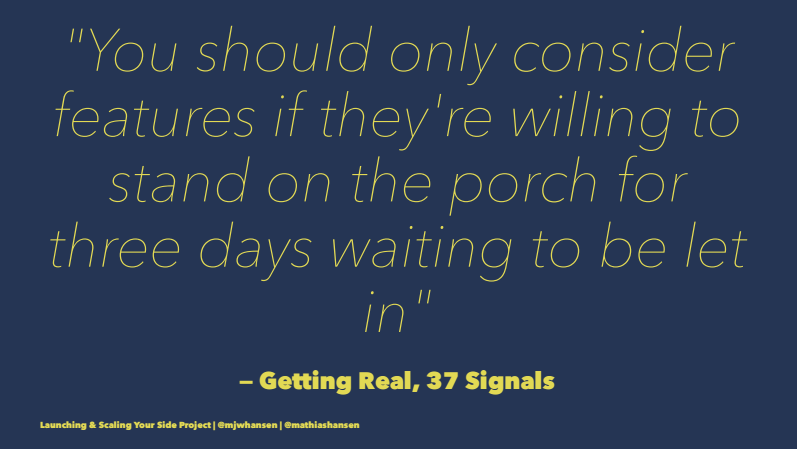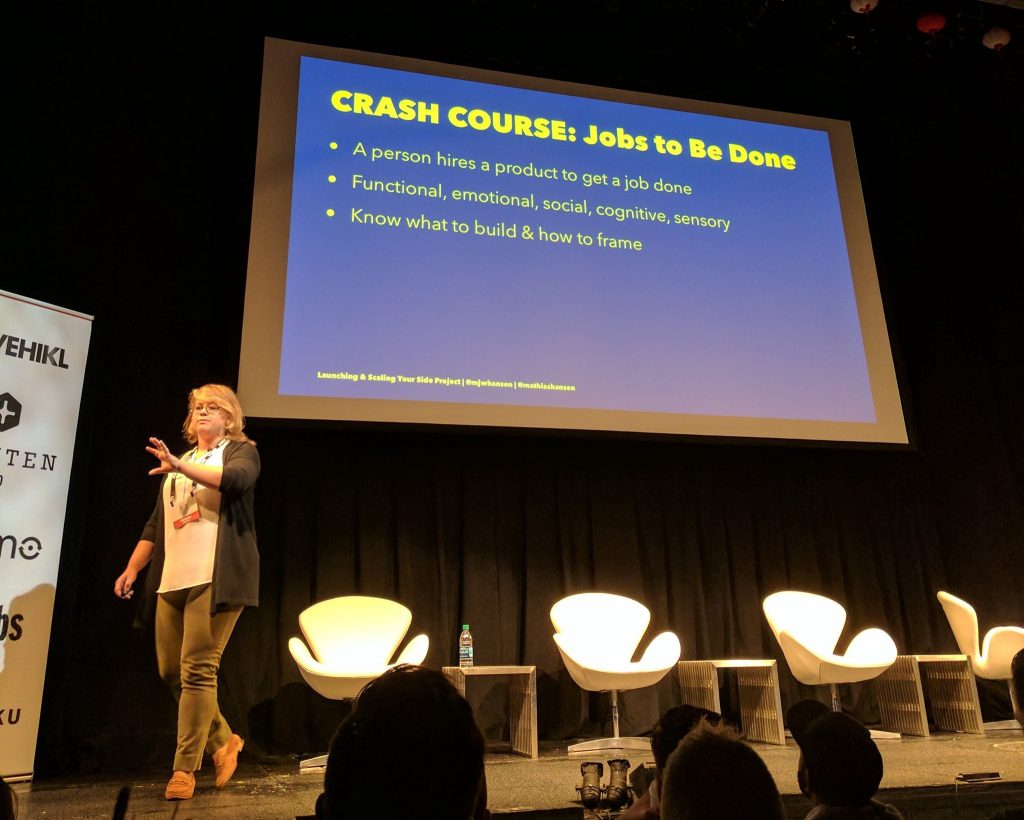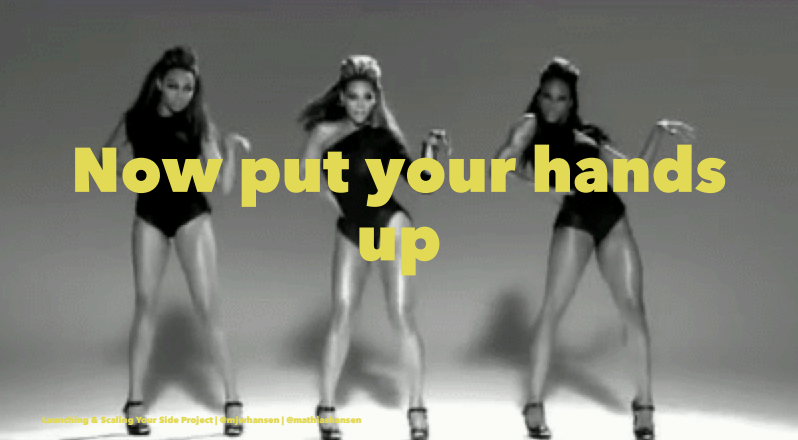This past week, I had the fortune of co-presenting a talk at Laracon in NYC on Launching and Scaling a Side Project. It was my first time speaking at a conference, and since I lived to tell the tale, I figured I’d share what I learned in the process.
1. Deckset is awesome, use it.
I resisted. I normally make slides in Google Slides, but my co-presenter, my husband, insisted on using his go-to, Deckset. Ugh, markdown. And we had to share the slides in Dropbox since we were collaborating. It felt so old school. But for someone whose design skills are limited to picking a cool font when I’m writing a Google Doc, it was a godsend to have a set of beautiful slide templates to flip through. The result? Our presentation came out looking spiffier than a 1930s tap dancer. $27 well spent.

2. Literally everyone struggles with displays.
Almost every presenter at the conference struggled with mirroring displays and getting their presentation to show up on the projector on the first try. As a first-time presenter, it was reassuring to see that even seasoned presenters struggle sometimes.
Of course, we confidently thought to ourselves as we watched them, Oh, that’s not going to happen to us. But it did! So to anyone out there looking for product ideas: make it easier for people to connect their laptops to the projector correctly on the first try. If a bunch of developers can’t figure it out on the first try, that’s a pretty good sign something is broken.
3. You can still give a talk, even if you can’t talk.
The Monday beforehand, I woke up coughing, sneezing, and with a gravelly voice: a nightmare scenario for someone who was supposed to talk, and project, for 45 minutes straight to 500 people. Over the next two days, which were filled with many conversations in loud New York City restaurants, my voice (and cough) got significantly worse, and developed into what I’d later learn was bronchitis. No amount of tea, cough drops, or soup seemed to do the trick: I still sounded like a frog.

So instead, once I got out on stage and introduced myself, I mentioned I had a cough, took ample swigs my water bottle, and got on with the show. Because…
4. Once you get up there, own it.
That cough you’ve developed? The slide you meant to move around? The slide you accidentally moved to the wrong place? None of that matters once you’re up on stage, and whatever you have, whatever you are, is what you have to roll with. This was a terrifying yet exhilarating realization. You’re up there because you have something to share that the conference organizers think is useful or insightful to the audience, and you have to will that into existence despite what life has thrown at you in that moment. As Mailchimp says right before you send out an email, this is your moment of glory.

5. Make yourself laugh.
A presentation is a serious endeavor, but if you’re tight the whole time, it won’t be enjoyable for the audience. So put things into your presentation that are designed to make the audience laugh — and loosen you up.
My approach was to co-opt the hand-raising questions that are part of the beginning of any talk —you know, the “How many of you have ever used X” sort of things. The prompt was something everyone would say yes to (“How many of you have ever been frustrated?”), then threw up a Beyonce gif. Audience laughed, I laughed. Worked like a charm.

6. People might pay attention.
This might seem like a strange point, but I’d done all of my preparation assuming that everyone in the audience would be staring at their phones or laptops the entire time: a sea of eyeballs focused on glowing screens with only occasional glance up at the presentation. So we strategically packed the presentation with Parks and Rec gifs and other pop culture references, thinking it would pull people away from their phones.
The reality was the complete opposite: most of the people in the audience seemed to be looking directly at me, only taking our their phones to take pictures of the slides behind me. It was somewhat jarring to have people paying attention to what I was saying, and caught me off guard several times throughout the talk.
7. No matter how much time you have to prepare, you’ll probably think you could have done better.
We started preparing our talk in February, giving us a cool five months to prepare. We made several outlines and even a full script of what we might say. We did run-throughs. And yet, after we got off the stage, we realized there were things we’d forgotten to say. Or anecdotes we could’ve told in a funnier way. Or slides that should have been in a different order. Or had more imagery. But, c’est la vie: we still got our points across.
8. Reading people’s comments after is scarier than being up on stage.
I admit, when I saw this Laracon 2017 Recap I got a pit in my stomach. Oh god, what if they say our talk was terrible? Or boring? It felt like a risky click. So was scrolling through Twitter a little while after we go off the stage. But as far as I was able to tell, people — or at least people using the conference hashtag — mostly had positive or neutral observations. I’ll take it!
9. Lastly, people’s comments in person afterwards made it all worth it.
After the talk, we had dozens of people come up to us and tell us that we’d inspired them to finally finish up their project and launch it, ask us questions about things on the business side that had held them back, or show off their projects to us. Leading up to the conference, I had been a little nervous since I’d never been to this conference before and was a non-developer giving a talk at a conference for developers; all of that made me worried about what I’d talk about outside of the talk. But giving a talk means that people will come right up to you and strike up a conversation about a topic you presumably enjoy. And I love talking through business problems with people and helping them problem-solve, so the hour or two after the talk ended up being the most fun part of the entire conference. I loved hearing about everyone’s projects. Our sole reason for doing the talk was to empower others and give them that last little push towards launching their side projects, and knowing that we accomplished our goal was so incredibly gratifying.
And my purposes here are similar
I’m willing to bet you have experiences and knowledge that would be helpful to others. Whether it’s for a local meetup or a conference, you probably have a talk in you somewhere, too, and I hope this gives you that push to go out and submit. You’ll survive whatever comes your way — I did!